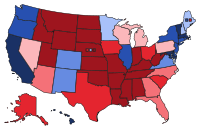Cook Partisan Voting Index

The Cook Partisan Voting Index (PVI) is a way to measure how strongly a political party is supported in a certain area. It's like a game, where we compare the number of people who vote for one party to the number of people who vote for the other party.
Imagine there are 100 kids in your school, and 60 of them like red apples and 40 of them like green apples. If we say that red apples are like one political party and green apples are like the other political party, then we can see that the red apples have more supporters than the green apples. In this example, the Cook PVI would be +20 for the red apples.
Now, let's say that some of the kids who like red apples move away, while some new kids who like green apples move in. So now, there are 50 kids who like red apples and 50 kids who like green apples. In this case, we would say that the kids are evenly split between the two parties, and the Cook PVI would be 0.
The Cook PVI helps us understand which areas of the country are more likely to vote for Democrats or Republicans. If an area has a high Cook PVI score for Democrats, then it means they are more likely to vote for Democratic candidates. If an area has a high Cook PVI score for Republicans, then it means they are more likely to vote for Republican candidates.
In summary, the Cook Partisan Voting Index is a way to measure how much support there is for political parties in a certain area. It helps us understand which areas are more likely to vote for Democrats or Republicans.
Imagine there are 100 kids in your school, and 60 of them like red apples and 40 of them like green apples. If we say that red apples are like one political party and green apples are like the other political party, then we can see that the red apples have more supporters than the green apples. In this example, the Cook PVI would be +20 for the red apples.
Now, let's say that some of the kids who like red apples move away, while some new kids who like green apples move in. So now, there are 50 kids who like red apples and 50 kids who like green apples. In this case, we would say that the kids are evenly split between the two parties, and the Cook PVI would be 0.
The Cook PVI helps us understand which areas of the country are more likely to vote for Democrats or Republicans. If an area has a high Cook PVI score for Democrats, then it means they are more likely to vote for Democratic candidates. If an area has a high Cook PVI score for Republicans, then it means they are more likely to vote for Republican candidates.
In summary, the Cook Partisan Voting Index is a way to measure how much support there is for political parties in a certain area. It helps us understand which areas are more likely to vote for Democrats or Republicans.
Related topics others have asked about:
